Over the past 12 years, that one route has developed into a network with access to cities in 25 countries, covering all European countries and regions and forming a Eurasian international logistics corridor, according to China State Railway Group, the national railway operator.
In 2017, a development plan issued by the National Development and Reform Commission highlighted the rail links as crucial to the Belt and Road Initiative.
When the service started, the trains carried a limited range of goods — mainly electronic devices such as mobile phones and laptop computers.
So far, the service has transported more than 50,000 types of goods, including clothing, automobiles, grain, wine, coffee beans and wood.
The rich variety of products can meet all the needs of people along all the routes, according to Xu Jianping, director of the Department of Regional Opening-up at the NDRC.
The China-Europe freight train service is cheaper and greener than other means of transport because the cost is about 20 percent that of air carriage, while the journey time is about 25 percent that of transportation by sea, Xu said.
Compared with air and sea transportation, the freight trains are more stable and less affected by the natural environment, thereby attracting products with greater added value.
As the COVID-19 pandemic hit the global supply chain in the past three years, especially in 2020 and 2021, the freight train service served as an important route to stabilize distribution channels across the world.
On March 21, 2020, the first China-Europe freight train carrying epidemic control supplies departed Yiwu in East China’s Zhejiang province and headed to Madrid, Spain, to assist in the battle against the disease.
The service also cooperated with Chinese and international enterprises, such as Dell and Lenovo, to offer logistics solutions during the pandemic.





